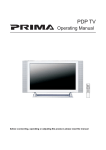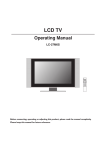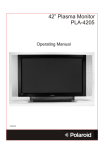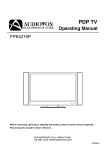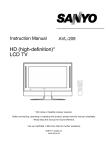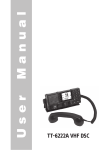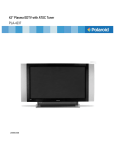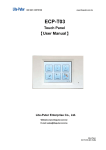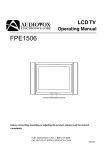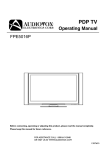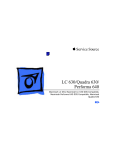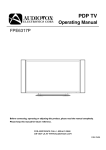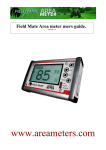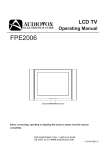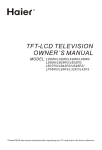Download Acoustic Research AR4200 User's Manual
Transcript
42 inch Plasma TV Operating Instructions Model No.: AR4200 For assistance, please call: 1-800-619-3848 Before connecting, operating or adjusting this product, please read these instructions completely. Please keep this manual for future reference 128-7120 Table of Contents Important Information...................................................................................................................1 Important Safety Precautions ......................................................................................................2 Preparations...................................................................................................................................5 Using the Remote Control ....................................................................................................5 Batteries for the Remote Control .........................................................................................5 Power connection .................................................................................................................6 Speaker connection..............................................................................................................6 Antenna Connection ............................................................................................................7 Identification of Controls ..............................................................................................................8 Main unit (front view) ............................................................................................................8 Main unit (rear view) .............................................................................................................9 Remote Control ....................................................................................................................10 Connections .................................................................................................................................12 Cautions before connecting ..............................................................................................12 Connect a VCR ....................................................................................................................12 Connect a Camcorder........................................................................................................13 Connect a DVD player ........................................................................................................14 Connect a DTV receiver ......................................................................................................15 Connect a PC .......................................................................................................................16 Connect a VCR (for recording) or external amplifier ......................................................17 Turning the Unit On and Off ........................................................................................................18 Memorizing the Channels ...........................................................................................................19 Selecting the Signal Source.................................................................................................19 Storing Channels in Memory Automatically ......................................................................19 Setting Auto Fine Tune (AFT)................................................................................................20 Manual Fine Tuning ..............................................................................................................20 Adding and Erasing Channels ............................................................................................20 Basic Operations ..........................................................................................................................21 Changing Channels .............................................................................................................21 Adjusting the Volume...........................................................................................................21 Select input source signal....................................................................................................22 Selecting a MENU language ...............................................................................................22 Setting Channel Options .............................................................................................................23 Editing Channel Label..........................................................................................................23 Setting Picture...............................................................................................................................24 Customizing the Picture .......................................................................................................24 Using the Preset Picture Mode ............................................................................................24 Setting System...............................................................................................................................25 Setting the Menu Background............................................................................................25 Setting Sleep Timer ...............................................................................................................25 Changing Screen Options...........................................................................................................26 Changing the Scaling mode of Image..............................................................................26 Freezing the Picture..............................................................................................................26 Changing the Position of the Image..................................................................................27 Using Digital Pan and Zoom ................................................................................................27 Table of Contents Setting Sound ...............................................................................................................................28 Using the Preset Audio Mode .............................................................................................28 Customizing the Sound........................................................................................................28 Adjusting the Headphone Volume ....................................................................................28 Choosing a Multi-Channel Sound (MTS) Soundtrack.......................................................29 Using the Auto Volume........................................................................................................29 Changing Screen Layout............................................................................................................30 Selecting Screen Layout......................................................................................................30 PIP...........................................................................................................................................31 Split Screen............................................................................................................................31 POP3 ......................................................................................................................................31 Grid ........................................................................................................................................31 PIP Operations ..............................................................................................................................32 Viewing the Picture-in-Picture.............................................................................................32 Swap the Contents of the PIP Image and Main Image .................................................32 Changing the Position of the PIP Frame............................................................................33 Adjusting the Size of PIP Frame...........................................................................................33 Adjustment in PC (VGA) Mode ..................................................................................................34 Adjusting Picture ..................................................................................................................34 Adjusting the Phase and Frequency..................................................................................34 Adjusting the Picture Automatically ..................................................................................34 Changing the Scaling mode of Image .............................................................................35 Changing the Position of Image ........................................................................................35 Displaying the Information ..................................................................................................35 Adjustment in YPbPr Mode .........................................................................................................36 Changing the Scaling mode of Image .............................................................................36 Changing the Position of Image.........................................................................................36 Adjusting Image width and height.....................................................................................36 Viewing Closed Captions ...........................................................................................................37 Setting Closed Caption .......................................................................................................37 Setting the Background of Closed Caption .....................................................................37 Adjusting V-CHIP Settings ............................................................................................................38 V-CHIP....................................................................................................................................38 Accessing the V-CHIP Menu ...............................................................................................40 Changing the Password ......................................................................................................40 Adjusting the Movie Rating .................................................................................................41 Adjusting the TV Rating........................................................................................................41 Troubleshooting............................................................................................................................42 Specifications ...............................................................................................................................43 Dimensional Drawings .................................................................................................................45 Important Information WARNING: TO REDUCE THE RISK OF FIRE OR ELECTRIC SHOCK, DO NOT EXPOSE THIS APPARATUS TO RAIN OR MOISTURE. CAUTION RISK OF ELECTRIC SHOCK DO NOT OPEN CAUTION-To reduce the risk of electric shock, do not perform any servicing other than that contained in the operating instructions The lightning flash with arrowhead symbol, within an equilateral triangle is intended to alert the user to the presence of uninsulated dangerous voltage within the product's enclosure that may be of sufficient magnitude to constitute a risk of electric shock to persons. The exclamation point within an equilateral triangle is intended to alert the user to the presence of important operating and maintenance (servicing) instructions in the literature accompanying the appliance. "Note to CATV system installer: This reminder is provided to call the CATV system installer's attention to Article 820-40 of the National Electrical Code that provides guidelines for proper grounding and, in particular, specifies that the cable ground shall be connected to the grounding system of the building, as close to the This product utilizes tin-lead solder, and fluorescent lamp containing a small amount of mercury. Disposal of these materials may be regulated due to environmental considerations. For disposal or recycling information, please contact your local authorities or the Electronic Industries Alliance: www.eia.org FCC STATEMENT FCC Notice PDP TV: A CLASS B digital device This equipment has been tested and found to comply with the limits for a Class B digital device, pursuant to part 15 of the FCC Rules. These limits are designed to provide reasonable protection against harmful interference when the equipment is operated in a commercial environment. This equipment generates, uses, and can radiate radio frequency energy and, if not installed and used in accordance with the instruction manual, may cause harmful interference to radio communications. Operation of this equipment in a residential area is likely to cause harmful interference in which case the user will be required to correct the interference at his own expense. FCC CAUTION: Pursuant to 47CFR, Part 15.21 of the FCC rules, any changes or modifications to this monitor not expressly approved by the manufacturer could cause harmful interference and would void the user's authority to operate this device. WARNING: This is a CLASS B product. In a domestic environment this product may cause radio interference in which case the user may be required to take adequate measures to counter interference. 1 Important Safety Precautions Electrical energy can perform many useful functions, but it can also cause personal injuries and property damage if improperly handled. This product has been engineered and manufactured with the highest priority on safety. But IMPROPER USE CAN RESULT IN POTENTIAL ELECTRICAL SHOCK OR FIRE HAZARD. In order to prevent potential danger, please observe the following instructions when installing, operating and cleaning the product. To ensure your safety and prolong the service life of your PDP TV product, 1. Read these instructions---All operating instructions must be read and understood before the product is operated. 2. Keep these instructions---These safety and operating instructions must be kept in a safe place for future reference. 3. Heed all warnings---All warnings on the product and in the instructions must be observed closely. 4. Follow all instructions---All operating instructions must be followed. 5. Do not use this apparatus near water---for example, near a bathtub, washbowl, kitchen sink, or laundry tub, in a wet basement, or near a swimming pool, and the like. Do not use immediately after moving from a low temperature to high temperature environment, as this causes condensation, which may result in fire, electric shock, or other hazards. 6. Clean only with dry cloth---Unplug this product from the wall outlet before cleaning. Do not use liquid cleaners or aerosol cleaners. Use a damp cloth for cleaning. 7. Ventilation---Do not block any ventilation openings. Install in accordance with the manufacturer instructions. The vents and other openings in the cabinet are designed for ventilation. Do not cover or block these vents and openings since insufficient ventilation can cause overheating and/or shorten the life of the product. Do not place the product on a bed, sofa, rug or other similar surface, since they can block ventilation openings. This product is not designed for built-in installation; do not place the product in an enclosed place such as a bookcase or rack, unless proper ventilation is provided or the manufacturer’s instructions are followed. 4” clearance on all sides and back are required 8.Heat sources---Do not install near any heat sources such as radiators, heat registers, stoves, or other apparatus (including amplifiers) that produce heat. 9.Grounding or Polarization---Do not defeat the safety purpose of the polarized or grounding-type plug. A polarized plug has two blades with one wider than the other. A grounding type plug has two blades and a third grounding prong. The wide blade or the third prong are provided for your safety. If the provided plug does not fit into your outlet, consult an electrician for replacement of the obsolete outlet. 10.Power cord protection---Protect the power cord from being walked on or pinched particularly at plugs, convenience receptacles, and the point where they exit from the apparatus. 11.Attachments---Only use attachments/accessories specified by the manufacturer. Do not use attachments not recommended by the manufacturer. Use of improper attachments can result in accidents. 2 Important Safety Precautions (continued) 12. Stand---Use only with the cart, stand, tripod, bracket, or table specified by the manufacturer, or sold with the apparatus. Do not place the product on an unstable trolley, stand, tripod or table. Placing the product on an unstable base can cause the product to fall, resulting inserious personal injuries as well as damage to the product. When mounting the product on a wall, be sure to follow the manufacturer’s instructions. Use only the mounting hardware recommended by the manufacturer. 13.Careful move---When a cart is used, use caution when moving the cart/apparatus combination to avoid injury from tip-over. Sudden stops, excessive force and uneven floor surfaces can cause the product to fall from the trolley. 14. Lightning---Unplug this apparatus during lightning storms or when unused for long periods of time. For added protection for this television equipment during a lightning storm, or when it is left unattended and unused for long periods of time, unplug it from the wall outlet and disconnect the antenna. This will prevent damage to the equipment due to lightning and power-line surges. 15. Servicing---Refer all servicing to qualified service personnel. Servicing is required when the apparatus has been damaged in any way, such as power-supply cord or plug is damaged, liquid has been spilled or objects have fallen into the apparatus, the apparatus has been exposed to rain or moisture, does not operate normally, or has been dropped. 16. Replacement parts---In case the product needs replacement parts, make sure that the service person uses replacement parts specified by the manufacturer, or those with the same characteristics and performance as the original parts. Use of unauthorized parts can result in fire, electric shock and/or other danger. 17.Overloading---Do not overload wall outlets, extension cords, or convenience receptacles on other equipment as this can result in a risk of fire or electric shock. 18.Entering of objects and liquids---Never insert an object into the product through vents or openings. High voltage flows in the product, and inserting an object can cause electric shock and/or short internal parts. For the same reason, do not spill water or liquid on the product. 19.Damage requiring service---If any of the following conditions occurs, unplug the power cord from the AC outlet, and request a qualified service person to perform repairs. a. When the power cord or plug is damaged. b. When a liquid is spilled on the product or when objects have fallen into the product. c. When the product has been exposed to rain or water. d. When the product does not operate properly as described in the operating instructions. Do not touch the controls other than those described in the operating instructions. Improper adjustment of controls not described in the instructions can cause damage, which often requires extensive adjustment work by a qualified technician. e. If the product has been dropped or the cabinet has been damaged in any way. f. When the product displays an abnormal condition or exhibits a distinct change in performance. Any noticeable abnormality in the product indicates that the product needs servicing. 20.Safety checks---Upon completion of service or repair work, request the service technician to perform safety checks to ensure that the product is in proper operating condition. 21.Wall or ceiling mounting---When mounting the product on a wall or ceiling, be sure to install the product according to the method recommended by the manufacturer. This is a safety feature. 3 Important Safety Precautions (continued) 22. Power source---This product is intended to be supplied by a listed power supply indicated on the marking label. If you are not sure of the type of power supply to your home, consult your product dealer or local power company. For added protection for this product during a lightning storm, or when it is left unattended and unused for long periods of time, unplug it from the wall outlet and disconnect the cable system. This will prevent damage to the product due to lightning and power line surges. When the unit has to be used with another power supply voltage, the power cable must be changed. Consult your product dealer. The socket outlet should be installed near the equipment and easily accessible. Use only the power cord designated by our dealer to ensure safety and EMC. When connecting other products such as VCRs and personal computers, you should turn off the power of the unit for protection against electric shock. 23.Panel protection---The PDP panel used in this product is made of glass. Therefore, it can break when the product is dropped or impacted upon by other objects. Be careful not to be injured by broken glass pieces in case the PDP panel breaks. 24.Pixel defect---The PDP panel is a very high technology product, giving you finely detailed pictures. Occasionally, a few non-active pixels may appear on the screen as a fixed point of blue, green or red. Please note that this does not affect the performance of your product. <If an outside antenna is connected to the television equipment, be sure the antenna system is grounded so as to provide some protection against voltage surges and built-up static charges. Section 810 of the National Electrical Code provides information with respect to proper grounding of the mast and supporting structure, grounding of the lead-in wire to an antenna discharge unit, size of grounding conductors, location of antenna-discharge unit, connection to grounding electrodes, and requirements for the grounding electrode. EXAMPLE OF ANTENNA GROUNDING AS PER NATIONAL ELECTRICAL CODE NEC—NATIONAL ELECTRICAL CODE <An outside antenna system should not be located in the vicinity of overhead power lines or other electric light or power circuits, or where it can collide with such power lines or circuits. When installing an outside antenna system, extreme care should be taken to keep from touching such power lines or circuits, as contact with them might be fatal. 4 Preparations Using the Remote Control <Use the remote control by pointing it towards the remote sensor window of the set. Objects between the remote control and sensor window may prevent proper operation. Note: the illustration is for your reference only, the remote sensor may locate differently with different model. SOURCE MENU 30 VOL CH 30 5m Cautions regarding use of remote control <Do not expose the remote control to shock. In addition, do not expose the remote control to liquids, and do not place in an area with high humidity. <Do not install or place the remote control under direct sunlight. The heat may cause deformation of the unit. <The remote control may not work properly if the remote sensor window of the main unit is under direct sunlight or strong lighting. In such a case, change the angle of the lighting or PDP TV set, or operate the remote control closer to the remote sensor window. Batteries for the Remote Control If the remote control fails to operate the PDP TV functions, replace the batteries in the remote control. 1 Open the battery cover. <(Slide the cover while pressing down.) 2 Insert two size-AAA batteries. 3 Replace the cover and slide in reverse until the lock snaps. <(Place the batteries with their terminals corresponding to the (+) and (–) indications in the battery Precaution on battery use Improper use of batteries can result in a leakage of chemicals and/or explosion. Be sure to follow the instructions below. <Place batteries with their terminals corresponding to the (+) and (–) indications. <Different types of batteries have different characteristics. Do not mix batteries of different types. <Do not mix old and new batteries. Mixing old and new batteries can shorten the life of new batteries and/or cause old batteries to leak chemicals. <Remove batteries as soon as they are non-operable. Chemicals that leak from batteries can cause a rash. If chemical leakage is found, wipe with a cloth. <The batteries supplied with the product may have a shorter life expectancy due to storage conditions. <If the remote control is not used for an extended period of time, remove the batteries from the remote control. 5 Preparations (continued) Power connection Household power Plug into AC outlet. AC cord SPEAKER R CONTROL L DVI AUDIO COMPONENT INPUT 1 D-SUB PIC AUDIO PIC Y Cb /Pb Cr /Pr AUDIO COMPONENT INPUT 2 Y Cb /Pb Cr /Pr AUDIO HEADPHONE AV OUTPUT VIDEO L AUDIO R AV INPUT VIDEO RF SVHS AC- INPUT L AUDIO R 1. Connecting the female plug to the AC socket on the unit. 2. Connecting the male plug to the wall outlet as illustrated. Note: <This product should be operated only from the type of power source indicated on the marking label. <Always unplug the AC cord from power outlet when not using for a long period of time. Speaker connection (Optional) SPEAKER R CONTROL L DVI AUDIO COMPONENT INPUT 1 D-SUB PIC AUDIO PIC Y Cb /Pb Cr /Pr AUDIO COMPONENT INPUT 2 Y Cb /Pb Cr /Pr AUDIO HEADPHONE AV OUTPUT VIDEO L AUDIO R AV INPUT VIDEO RF SVHS £º£ £º£ (Black) £º£ £º£ Ï ÓÒ (Red) £º£ £º£ £º£ £º£ ラメマ Right Left speakerspeaker Note: the illustration may be different depending on model. 6 AC- INPUT L AUDIO R (Red) (Black) Connect the speaker audio cable to the external speaker output jack on the unit matching the "+" and "-" ends of the cable with color. Preparations (continued) Antenna Connection CABLE TV (CATV) CONNECTION A 75-ohm coaxial cable connector is built into the set for easy hookup. When connecting the 75- ohm coaxial cable to the set, screw the 75-ohm cable to the ANT. Terminal. Some cable TV companies offer “premium pay channels”. Since the signals of these premium pay channels are scrambled, a cable TV converter/descrambler is generally provided to the subscriber by the cable TV company. This converter/descrambler is necessary for normal viewing of the scrambled channels. For more specific instructions on installing cable TV, consult your cable TV company. One possible method of utilizing the converter/descrambler provided by your cable TV company is explained below. Please note: An RF switch provided with two inputs (A and B) is required (not supplied). RF switch (not supplied) Two-set signal splitter (not supplied) OUT Cable TV Line IN Cable TV converter/ descrambler (not supplied) “A” position on the RF switch (not supplied) : You can view all unscrambled channels by using the TV’s channel keys. “B” position on the RF switch (not supplied) : You can view the scrambled channels via the converter/descrambler by using the converter’s channel keys. Antenna connection (Continued) ANTENNAS The antenna requirements for good color television reception are more important than those for black & white television reception. For this reason, a good quality outdoor antenna is strongly recommended. The following is a brief explanation of the type of connections that are provided with the various antenna systems. 1. A 75-ohm system is generally a round cable with F-type connector that can easily be attached to a terminal without tools (not supplied). 2. A 300-ohm system is a flat “twin-lead” cable that can be attached to a 75-ohm terminal through a 300-75-ohm F-type connector 75-ohm coaxial cable (round) 300-ohm twin-lead cable (flat) OUTDOOR ANTENNA CONNECTION A. Combination VHF/UHF Antenna Use one of the following two diagrams if you connect an outdoor antenna. A: Using a VHF/UHF combination outdoor antenna. B: Using separate VHF and/or UHF outdoor antennas. Connect the outdoor antenna cable lead-in to the ANT. terminal on the rear of the TV set. 300/75-ohm adapter (not supplied) VHF/UHF antenna VHF/UHF antenna or 300-ohm twin-lead 75-ohm coaxial cable Antenna cable B. Separ ate VHFand/or UHF Antennas UHF antenna SPEAKER R CONTROL L DVI AUDIO COMPONENT INPUT 1 D-SUB PIC AUDIO PIC Y Cb /Pb Cr /Pr AUDIO COMPONENT INPUT 2 Y Cb /Pb Cr /Pr AUDIO HEADPHONE AV OUTPUT VIDEO L AUDIO R AV INPUT VIDEO RF SVHS VHF antenna 300-ohm twin-lead AC- INPUT L AUDIO R Combiner (not supplied) OUT 300-ohm twin-lead IN 75-ohm coaxial cable or Identification of Controls Main unit (front view) MENU SOURCE MENU VOL VOL CH CH REMOTE SENSOR POWER INDICATOR A blue indicator lights when the power is on and a red indicator lights when in the standby mode. BOTTOM VIEW MENU POWER SWITCH VOL CH POWER ON/STANDBY CHANNEL MENU DOWN/UP VOLUME DOWN/UP 1. POWER Press this button to turn the unit ON from STANDBY mode. Press it again to turn the set back to STANDBY. 2. MENU Press this button to access the MENU main page. 3. Volume 3/4 Press the VOL 4 or VOL3button to directly increase or decrease the sound volume level. In OSD Menu, press these buttons to adjust the value or setting of each item 4. Channel 5/6Press these two buttons to directly change the TV channel. In OSD Menu, press these buttons to choose the OSD items. 5. Power Switch: Press to remove power from the unit POWER , VOL3/4, CH5/6 and MENU on the main unit have the same functions as the corresponding buttons on the remote control. 8 Identification of Controls (continued) Main unit (rear view) AC power input socket Speaker output jacks SPEAKER L R AC - INPUT CONTROL SPEAKER R CONTROL D-SUB D-SUB DVI AUDIO PIC AUDIO DVI AUDIO L COMPONENT INPUT 1 D-SUB PIC AUDIO PIC Y COMPONENT INPUT 1 PIC Y Cb /Pb Cr /Pr AUDIO Cb /Pb Cr /Pr COMPONENT INPUT 2 AUDIO Y Cb /Pb Cr /Pr AUDIO HEADPHONE AV INPUT AV OUTPUT VIDEO L AUDIO R VIDEO RF SVHS AC- INPUT L AUDIO R COMPONENT INPUT 2 Y Cb /Pb Cr /Pr HEADPHONE AUDIO AV OUTPUT VIDEO L AUDIO R AV INPUT VIDEO RF SVHS 9 10 L AUDIO R BOTTOM VIEW 1 2 3 4 5 6 7 8 1. RS232 terminals For service use only. The user cannot operate the unit through the RS232 terminals. 2. DVI input /Audio in Receives the digital video/audio signals from a set top box. 3. VGA input /Audio in Connect to the VGA/audio output jacks on your PC. 4. Component inputs 1 (Y, Pb/Cb, Pr/Cr, Audio) Connect to the audio and component output jacks of a DVD player or Set-Top Box. 5. Component inputs 2 (Y, Pb/Cb, Pr/Cr, Audio) Connect to the audio and component output jacks of a DVD player or Set-Top Box. 6. Headphone jack 7. AV outputs (Video, Audio L, R) Connect to the VCR input jacks to record programs. 8. AV inputs (Video, Audio L, R) Receive video/audio signals from external sources such as VCR or DVD player. 9. Antenna input Allows you to connect cable or outdoor antenna. 10. S-Video input Receive a S-Video signal from external source such as VCR or DVD player. (Note: S-Video Shares audio input with AV input. 9 Identification of Controls (continued) Remote Control 10 1 2 - + 11 3 STILL ZOOM CLK SLP 4 5 12 13 6 7 14 15 8 9 16 1. POWER Turn the unit on or standby 2. CH5/6,VOL+/CH5/6---Use to switch channels; VOL+/----Use to adjust volume; In MENU operation, use CH5/6 to select menu item and VOL+/- to adjust selected item 3. MENU To access the MENU main page 4. STILL To freeze current picture 5. ZOOM To go into ZOOM or PAN mode 6. S.M To access sound mode select menu 7. P.M To access picture mode select menu 8. 0~9 digit buttons Direct channel select 9. SOURCE To access source select menu 10. MUTE Sound mute 11. ENTER To confirm your operation or setting or access the submenu 12. SLP To access Sleep timer setting menu 13. CLK To access Current time setting menu 14. RETURN To quickly jump between current channel and last selected channel. 15. DSP To display channel status or signal information 16. MTS To select STEREO, SAP or MONO Note: Remote layout subject to change Flip the cover, open in the direction of the 10 Identification of Controls (continued) Remote Control - STILL 17 18 + ZOOM CLK MENU MODE 24 POS 19 20 21 22 23 SLP 25 SIZE SWAP PIP SPEAKER AUTO 26 17. MODE To access screen layout select menu 18. PIP display To activate picture in picture 19. POS To access PIP frame position select menu 20. SIZE To access PIP frame size adjusting menu 21. SPEAKER In multi-picture mode, press this button to output the sound of the selected picture frame from speaker 22. SWAP To exchange PIP and MAIN PICTURE source 23. HEADPHONE In multi-picture mode, press this button to output the sound of the selected picture frame from headphone 24. MENU To access the MENU main page 25. 5634 56: To move upward or downward in menu operation; To adjust zoom rate in ZOOM mode and pan picture in PAN mode; To select picture frame in multi-picture mode, the selected picture frame displays with a green border; 34: To move left or right in menu operation; To adjust selected menu item in menu operation; To pan picture in PAN mode; : To confirm your operation or setting or to access a submenu. 26. AUTO To rectify the picture automatically in VGA mode Note: Remote layout subject to change 11 Connections Cautions before connecting Carefully check the terminals for position and type before making any connections. The illustration of the external equipment may be different depending on your model. Loose connectors can result in image or color problems. Make sure that all connectors are securely inserted into their terminals. Refer to the user manual of the external device as well. When connecting an external device, turn the power off on the panel to avoid any issues. Connect a VCR CONTROL D-SUB D-SUB DVI AUDIO PIC AUDIO COMPONENT INPUT 1 PIC Y Cr /Pr Cb /Pb COMPONENT INPUT 2 AUDIO Y Cb /Pb Cr /Pr HEADPHONE AUDIO AV INPUT AV OUTPUT VIDEO L AUDIO R VIDEO RF L AUDIO R BOTTOM VIEW Y Y W R Yellow (VIDEO) White (AUDIO L) Red (AUDIO R ) W R or Video cable Y Audio S-video cable cable W R VCR ANT OUT AV OUT VIDEO L AUDIO R S - VIDEO ANT IN AV IN VIDEO L AUDIO R Rear of the VCR How to connect: Connect the Audio/Video cables between the Audio (L/R)/Video jacks on the unit and VCR. Note: For better video, you can use the S-video terminal if your source supports it. When you use S-video terminal, the source menu displays SV instead of AV. S-video and AV input can not be used together. S-Video is master over AV To play VCR 1. Turn on your PDP TV , press SOURCE button on the remote control. 2. Press VOL+/- to select AV (VIDEO) and press ENTER to 12 source A D C1 C2 AV TV VIDEO SVHS Connections (continued) Connect a Camcorder CONTROL D-SUB D-SUB DVI AUDIO PIC AUDIO COMPONENT INPUT 1 PIC Y Cb /Pb Cr /Pr COMPONENT INPUT 2 AUDIO Y Cb /Pb Cr /Pr HEADPHONE AUDIO AV INPUT AV OUTPUT VIDEO L AUDIO R VIDEO RF SVHS L AUDIO R BOTTOM VIEW Y Y W R W R Yellow (VIDEO) White (AUDIO L) Red (AUDIO R ) Video cable Y VIDEO Audio cable W OUT IN R L AUDIO R How to connect: Connect the Audio/Video cables between the Audio (L/R)/Video jacks on the unit and camcorder. To playback Camcorder 1. Turn on your PDP TV , press SOURCE button on the remote control. 2. Press VOL+/- to select AV (VIDEO) and press ENTER to confirm. 3. Turn on your camcorder and set it to output mode. (For details, refer to your camcorder user Note: The operations of the camcorder may be different and is source A D C1 C2 AV TV VIDEO 13 Connections (continued) Connect a DVD player CONTROL D-SUB D-SUB DVI AUDIO PIC AUDIO COMPONENT INPUT 1 PIC Y Cr /Pr Cb /Pb COMPONENT INPUT 2 AUDIO Y Cr /Pr Cb /Pb AUDIO HEADPHONE AV OUTPUT VIDEO L AUDIO R AV INPUT VIDEO RF SVHS L AUDIO R BOTTOM VIEW G W B R white (audio L) R red (audio R, Pr /C r ) Video cable G Green (Y) Audio cable B Blue (P b /Cb ) R B G R W DVD player COMPONENT AUDIO Pb L AUDIO R Pr Y AV OUT R AUDIO L VIDEO S - VIDEO Rear of the DVD player How to connect a DVD Player using Component Video Connections: Connect the Video cable between the Y, Cb, Cr input jacks on the unit and Y, Cb, Cr output jacks on the DVD player. To play DVD 1. Turn on your PDP TV , press SOURCE button on the remote 4. Turn on your DVD player, insert a DVD disc and press the source A D C1 C2 AV TV YPbPr1/YCbCr1 Note: This unit identifies the type of component video terminals automatically. If you connect Y, Cb, Cr terminals, the screen displays YCbCr detected on the bottom-right corner. Similarly, if the component 14 Connections (continued) Connect a DTV receiver CONTROL D-SUB D-SUB DVI AUDIO PIC AUDIO COMPONENT INPUT 1 PIC Y Cr /Pr Cb /Pb COMPONENT INPUT 2 AUDIO Y Cr /Pr Cb /Pb HEADPHONE AUDIO AV OUTPUT VIDEO L AUDIO R AV INPUT VIDEO RF SVHS L AUDIO R BOTTOM VIEW G W B R white (audio L) R red (audio R, Pr /C r ) Video cable G Green (Y) Audio cable B Blue (P b /Cb ) R B G R W COMPONENT AUDIO Pb L AUDIO R Pr Y AV OUT R AUDIO L VIDEO S - VIDEO ANT DVI Rear of the DTV receiver How to connect: Connect the cable or antenna to the antenna input jack on the DTV receiver. Connect the Video cable between the Y, Pb, Pr input jacks on the unit and Y, Pb, Pr output jacks on the DTV receiver . To Watch DTV 1. Turn on your PDP TV , press SOURCE button on the remote control. 2. Press VOL+/- to select C1(YPbPr1/YCbCr1) or C2(YPbPr2/YCbCr2). source A D C1 C2 AV TV YPbPr1/YCbCr1 15 Connections (continued) Connect a PC CONTROL D-SUB D-SUB DVI AUDIO AUDIO PIC COMPONENT INPUT 1 PIC Y Cb /Pb Cr /Pr AUDIO COMPONENT INPUT 2 Y Cb /Pb Cr /Pr AUDIO HEADPHONE AV OUTPUT VIDEO L AUDIO R AV INPUT VIDEO RF SVHS L AUDIO R BOTTOM VIEW VGA cable Audio cable How to connect: Connect a VGA cable between the VGA jack on the PC and the VGA input jack on the unit. Connect an Audio cable between the AUDIO output on the PC and AUDIO input jack on the unit. To Watch the PC screen 1. Turn on your PDP TV , press SOURCE remote control. 2. Press VOL+/- to select A (VGA). 3. Press ENTER to confirm. button on the source A D C1 C2 AV TV VGA 16 Connections (continued) Connect a VCR (for recording) or external amplifier CONTROL D-SUB D-SUB DVI AUDIO PIC AUDIO COMPONENT INPUT 1 PIC Y Cb /Pb Cr /Pr COMPONENT INPUT 2 Y AUDIO Cb /Pb Cr /Pr HEADPHONE AUDIO AV INPUT AV OUTPUT VIDEO L AUDIO R VIDEO RF SVHS L AUDIO R BOTTOM VIEW Y Y W R Audio cable R W R Yellow (VIDEO) White (AUDIO L) Red (AUDIO R ) Audio cable R W W Video cable Y VCR for recording To Audio inputs ANT OUT AV OUT R AUDIO L VIDEO S - VIDEO ANT IN AV IN R AUDIO L External Amplifier VIDEO Rear of the VCR How to connect: Connect the Audio/Video cables between the Audio (L/R)/Video jacks on the unit and VCR. - or Connect the Audio cables between the Audio (L/R) jacks on the unit and external amplifier. To record program 1. Turn on your PDP TV, select AV or TV source you wish to record. 2. Turn on your VCR, insert a videotape for recording. 3. Press the Record button to begin recording. To enjoy high-quality sound through an external amplifier 1. Turn on your PDP TV, select AV or TV source. 2. Turn the main volume of the amplifier to minimum. 3. Turn on the amplifier and adjust for a proper volume. Note: The operations of the amplifier may be different depending on model. Please read the user manual of your amplifier to confirm proper operation. The AV output terminals output audio/video signal inputted from Antenna input or AV inputs only. 17 Turning the Unit On and Off Turning the Unit On and Off Turning On Insert the power cord into the wall outlet. Press the Power Switch on the unit. Press the Power button on the remote control. - Turning Off + With the power on, Press the Power button on the remote control to turn off the unit temporarily. If you want to cut off Note: Viewing the Menus and Displays Your PDP TV has a simple, easy-to-use menu system that appears on the screen. This system makes it convenient and fast to use features on the unit. Viewing the Menus 1 With the power on, press the MENU button on the remote 2 Use the CH5/6to select menu item. Use VOL+/- to adjust value or setting of each item. Use ENTER to confirm or access items of menu. On-screen menu will disappear from the screen automatically after about 15 seconds, or you can press picture brightness contrast sharpness color tint 50 50 50 50 12 down for picture settings for current window - + Note: To clearly introduce the menu operations , this operation 3 In MENU operations, the 5/6buttons have the same function with the CH5/6buttons, the 3/4 buttons have the same function with the VOL+/- buttons, the button MENU MODE POS SIZE SWAP SPEAKER AUTO PIP Displaying Status Information Press the DSP button on the remote control, the unit will display current status information such as 18 Memorizing TV Channels Your PDP TV can memorize and store all of the available channels for both antenna and cable channels. After the available channels are memorized, use CH5/6to scan through the available Selecting the Signal Source Before your PDP TV can memorize the available channels, you must specify the type of signal source that is connected 1 2 3 Press MENU to display the menu main options Press VOL+/- repeatedly to display options menu page tv tuner content blocking Press CH6 to select tv tuner item. select to activate tuner menu 4 5 Press VOL+ or ENTER to access the submenu. If the search menu does not display, press VOL+/repeatedly to display search menu page. Press CH6 to select source item. 6 Press VOL+/- to select antenna or cable. search source antenna cable autoset <select> to enable auto fine tune off on 50 fine tune channel skip off on If you are connected to an antenna, please select antenna (the selected item displays in green). If you connect cable, please select cable. right/left to change source Storing Channels in Memory Automatically 1 Repeat steps 1~4 in [Selecting the Signal Source] to search 2 Press CH6 twice to select autoset item. source antenna cable autoset <select> to enable off on auto fine tune 50 fine tune off on channel skip select to activate autoset 3 Press ENTER to store channels in memory automatically. The unit will begin memorizing all of the available channels. Note: The process of auto memory will be stopped if you press the MENU button. channel searching please wait or press menu to cancel 12 19 Memorizing TV Channels (continued) Setting Auto Fine Tune (AFT) 1 Repeat steps 1~4 in [Selecting the Signal Source] to display search menu page. 2 Press CH6 repeatedly to select auto fine tune item. 3 Press VOL+/- to select on or off. When the AFT is set to On, the unit will automatically tune the program frequency to provide the best possible picture and sound. search source antenna cable autoset <select> to enable auto fine tune off on 50 fine tune off on channel skip right/left to adjust automatic fine tune Manual Fine Tuning 1 Repeat steps 1~4 in [Selecting the Signal Source] to display search menu page. 2 Press CH6 repeatedly to select fine tune item. 3 Press VOL+/- to fine tune till the best possible picture and sound are obtained. search source antenna cable autoset <select> to enable auto fine tune off on 50 fine tune channel skip off on right/left to adjust fine tuning If you fine tune a program manually, the auto fine tune item will be turned to off automatically. Adding and Erasing Channels 1 Use number buttons to directly select a channel that will be added or erased. 2 Repeat steps 1~4 in [Selecting the Signal Source] to display search menu page. 3 Press CH6 repeatedly to select channel skip item. 4 Press VOL+/- to select on or off. When the item is set to on, the selected channel will be erased. When the item is set to off, the selected channel will be added. The erased channels can not be selected by using the CH5/6 buttons unless you use number buttons to input channel number directly. 20 search source antenna cable autoset <select> to enable auto fine tune off on fine tune channel skip off on right/left to set channel skip 50 Basic Operations Changing Channels Using the Channel Buttons (CH5 or CH6) Press the CH5 or CH6 to change channels. When you press the CH5 or CH6, the unit changes channels in sequence. You will see all the channels that the unit has memorized. You will not see channels that were erased, not memorized or unavailable. Direct Accessing Channels Press the number buttons to go directly to a channel. To select a one-digit channel: Input the channel using the 0-9 number buttons directly and then press ENTER or wait for 3 seconds. To select a two-digit channel: Input the channel using the 0-9 number buttons directly and then press ENTER or wait for 3 seconds. To select a three-digit channel: Note: Be sure to enter the channel within 3 seconds. When you use the number buttons, You may directly select channels that were erased. Using the RETURN button Press this button to switch between the current channel and the previous channel. Adjusting the Volume Using the volume buttons (VOL-and VOL+) Press the VOL +or VOL- to increase or decrease the volume. Using the Mute Using the MUTE button At any time, you can temporarily turn off the sound using the MUTE 1 Press the MUTE button. button and the sound turns off. 2 To turn mute off, press the MUTE button again, or simply press either the VOL - or VOL+. 21 Basic Operations (continued) Select input source signal Using the SOURCE button 1 Press the SOURCE button to access source menu. 2 Press VOL+ or VOL- to select a desired input channel. 3 Press ENTER to confirm and the unit display signal from the selected input channel. A D C1 C2 AV TV source VGA A--------VGA, select signal from VGA (15-pin D-sub) terminals. D--------DVI, select signal from DVI terminals. C1------YPbPr1/YCbCr1, select signal from YPbPr1/YCbCr1 terminals. C2------YPbPr2/YCbCr2, select signal from YPbPr2/YCbCr2 terminals. AV -----VIDEO (SVIDEO), select signal from S-Video or Video terminal. The S-Video is prior to Video terminal when they are connected at the same time. TV ------Select TV signal. Note: This unit identifies the type of component video terminals automatically. If you connect Y, Cb, Cr terminals, the screen displays YCbCr detected on the bottom-right corner. Similary, if the component video terminals are Y, Pb, Pr, the screen displays YPbPr detected on the bottom-right corner. Using source select menu 1 2 3 4 Press MENU to display the menu main settings Press VOL+/- to display settings menu page. Press CH6repeatedly to select source select item. Press VOL+ to access source select menu. 5 Press CH5 or CH6 to select a desired input channel. 6 opaque menu background language English close caption mode cc1 close caption off on on mute opaque close capt. background source select right/left to source select Press ENTER to confirm and the unit displays signal from the selected input channel. Selecting a MENU language 1 Press MENU to display the menu main settings 2 Press VOL+/- repeatedly to display settings menu page 3 4 Press CH6twice to select language item. right/left to change language Press VOL+/- to select the appropriate language: English, French and Spanish. 5 Press MENU to exit. 22 opaque menu background English language close caption mode cc1 close caption off on on mute opaque close capt. background source select Setting Channel Options Editing Channel Label 1 Press MENU to display the menu main 2 Press VOL+/- repeatedly to display options menu page options tv tuner content blocking 3 Press CH6 to select tv tuner item. 4 Press VOL+ to enter. 5 Press VOL+again to display channel menu page. select to activate tuner menu channel edit labels 6 Press CH6to select edit labels item. 7 Press VOL+ to enter into channel label editing mode. select to edit channel labels 8 Use CH5/6 to select a channel you want add label to. Use 5/6 to select character. Use 3/4 to move cursor left or right. Use SOURCE to clear label text if you wish to reset. Use MENU to return. ABC channel up/down to change channels up/down/left/right to edit label source to clear label menu to return 23 Setting Picture Customizing the Picture 1 2 Press MENU to display the menu main If the picture menu does not display, press VOL+/repeatedly to display picture menu page. Press CH5/6to select the item you wish to change. 3 Press VOL+/- to adjust the value of the item. 4 Press MENU to exit. picture brightness contrast sharpness color tint 50 50 50 50 12 down for picture settings for current window Using the Preset Picture Mode 1 Press P.M on the remote to display picture mode select menu. 2 Press VOL+/- to select a desired picture mode. 3 Press MENU to exit. There are three preset picture modes (Normal, Bright and Soft) and one user-set picture mode (User). Each preset mode has its own picture settings. Normal: Select for a normal picture. Bright: Select for a bright picture. Soft: Select for a fine/soft picture. Adjusted settings are stored in User 24 Normal Picture mode menu to return right/left to adjust Setting System Setting the Menu Background 1 Press MENU to display the menu main 2 Press VOL+/- to display settings menu page. 3 Press CH6to select menu background item. 4 Press VOL+/- to select opaque or translucent. settings translucent menu background english language close caption mode cc1 close caption off on on mute opaque close capt. background source select right/left to change menu background Setting Sleep Timer 1 Press the SLP button to display sleep time menu. 2 Press VOL+/- to adjust. 3 Press MENU to exit. Sleep time menu to return off right/left to adjust 25 Changing Screen Options Changing the Scaling mode of Image 1 Press MENU to display the menu main page. 2 Press VOL+/- to display window menu page. window 3 Press CH6to select image size item. 4 Press VOL+/- to select a proper image size. The image size can be selected between: fill all, normal, wide and zoom . image size h position v position freeze window digital pan and zoom fill all 50 50 off on right/left to change image size Fill All The Fill All mode stretches the input vertically and horizontally to fill the display from edge to edge. This mode is the default mode. Normal The Normal mode fills the display vertically with a 4:3 aspect picture, preserving the geometry of the input format. Wide The Wide mode only affects displays that are greater than 4:3 aspect. If the picture is less than or equal to 4:3, this mode acts as if it is in Normal mode. It is intended to display 4:3 images on a 16:9 panel with the least picture deformity. The center of the picture is left unstretched. The left and right sides of the picture are stretched in a non-linear fashion with the areas of greatest distortion on the extreme left and right edges of the picture. The top and bottom five percent of the picture are cropped. Zoom If the display aspect ratio is greater than 4:3, this mode fills the panel horizontally, cropping 10 percent off the top and bottom of the picture. If the display aspect ratio is less than 4:3, this mode crops the picture by 16.5 percent on all sides and fills the panel with the remaining picture. Freezing the Picture 1 Press MENU to display the menu main page. 2 Press VOL+/- to display window menu page. window 3 Press CH6repeatedly to select freeze window item. 4 Press VOL+/- to select on or off. fill all 50 50 off left/right to freeze current window When you set this item to on, the current picture will be frozen until you set this item to off. Note: This menu item appears only when the current screen layout is full screen. You can also quickly freeze current picture by using the STILL button. 26 image size h position v position freeze window digital pan and zoom on Changing Screen Options (continued) Changing the Position of the Image The unit allows you to adjust the position of the image if it is not well-aligned. 1 2 Press MENU to display the menu main page. Press VOL+/- to display window menu page. 3 Press CH6repeatedly to select h position or v position 4 Press VOL+/- to adjust until the picture is well-aligned. window image size h position v position freeze window digital pan and zoom fill all 50 50 off on right/left to adjust h position Using Digital Pan and Zoom 1 Press MENU to display the menu main page. 2 Press VOL+/- to display window menu page. 3 4 5 Press CH6repeatedly to select digital pan and zoom Press VOL+to enter. window image size h position v position freeze window digital pan and zoom fill all 50 50 off on select to activate digital zoom control Press CH5/6to adjust zoom ratio. Note: You can quickly access Zoom menu by using the ZOOM button. Digital pan and zoom are not always available. The unit allows you to pan the picture after you zoom in the picture 1 2 3 1.00 up/down to zoom <select> for pan menu to exit Repeat steps 1~5 above to zoom in the picture. Press ENTER to access Pan mode. Press VOL+/- or CH5/6to pan the current picture in the relevant direction. 12.34 arrow keys to pan <select> for zoom menu to exit 27 Setting Sound Using the Preset Audio Mode 1 2 3 Press MENU to display the menu main page. audio Press VOL+/- to display audio menu page. Press CH6to select Audio mode item. 4Note:Press VOL+/- to select a desired Audio mode. Audio mode treble bass balance headphone MTS auto volume Cinema ーメトハ 50 50 50 50 STEREO off on right/left to set audio mode You can not access the treble and bass item unless the Audio mode is set to User. Customizing the Sound 1 2 Press MENU to display the menu main audio Press VOL+/- to display audio menu page. 3 Press CH5/6to select treble, bass or balance item. 4 Press VOL+/- to adjust the value of the item. Audio mode treble bass balance headphone MTS auto volume User 50 50 50 50 STEREO off on right/left to adjust treble Using the S.M button 1 2 3 Press S.M to display Audio mode select menu. Press VOL+/- to select a desired Audio mode. Press MENU to exit. There are three preset Audio modes (Cinema, Music and News) and one user-set Audio mode (User). Each preset mode has its own Audio settings. Cinema: Select for a movie program picture. Music: Select for a music program. News: Select for a speech or conversation program. Adjusted settings are stored in User mode. Audio mode Cinema menu to return right/left to adjust Adjusting the Headphone Volume 1 Press MENU to display the menu main 2 Press VOL+/- to display audio menu page. 3 Press CH6repeatedly to select headphone item. 4 Press VOL+/- to adjust the volume of headphone. 28 audio Audio mode treble bass balance headphone MTS auto volume Cinema 50 50 50 50 STEREO off on right/left to adjust headphone Setting Sound (continued) Choosing a Multi-Channel Sound (MTS) Soundtrack 1 Press MENU to display the menu main page. audio 2 Press VOL+/- to display audio menu page. 3 Press CH6repeatedly to select MTS item. 4 Press VOL+/- to select STEREO, SAP or MONO. Audio mode treble bass balance headphone MTS auto volume Cinema 50 50 50 50 STEREO off on right/left to set stereo Choose STEREO for channels that are broadcasting in stereo. Choose MONO for channels that are broadcasting in mono, or if you are having difficulty receiving a stereo signal. Choose SAP to listen to the Separate Audio Program, which is usually a foreign-language translation of a program. Using the MTS 1 Press the MTS button button to access MTS setting menu. 2 Press VOL+/- to select STEREO, SAP or MONO. 3 Press MENU to exit. MTS menu to return STEREO right/left to adjust Using the Auto Volume Each broadcasting station has its own signal conditions, which can make it necessary to adjust the volume every time the channel is changed. “Auto volume” lets you automatically adjust the volume of the desired channel by lowering the sound output when the modulation signal is high or by raising the sound output when the modulation signal is low. 1 Press MENU to display the menu main page. 2 Press VOL+/- to display audio menu page. 3 Press CH6repeatedly to select Auto volume item. 4 Press VOL+/- to select on or off. audio Audio mode treble bass balance headphone MTS auto volume Cinema 50 50 50 50 STEREO off on right/left to set auto volume 29 Changing Screen Layout Selecting Screen Layout Using the Layout Menu 1 Press MENU to display the menu main page. 2 Press VOL+/- to display layout menu page. 3 Press CH5/6 to select item. 4 Press VOL+or ENTER to confirm. layout full screen pip split screen pop3 grid down for current screen layout options Using the MODE button 1 2 3 4 Press the MODE button to display the screen layout select Press VOL+/- to select item. Press ENTER to confirm. Press MENU to exit. pip select to change layout menu to exit Full Screen When this item is selected, only main frame displays on the screen. Main Frame 30 Changing Screen Layout (continued) PIP When this item is selected, one main frame and one PIP frame display on the screen at the same time. Main Frame PIP Frame Split Screen When this item is selected, the screen will be split into two frames. Main Frame Split Frame POP3 2 When this item is selected, one main frame and three scanning frames display on the screen. Scanning Frame Main Frame 3 4 Grid 1 2 4 5 6 7 8 9 When this item is selected, the screen displays 9 scanning frames. Scanning Frame 3 31 PIP Operations Viewing the Picture-in-Picture 1 Press MENU to display the menu main page. layout 2 Press VOL+/- to display layout menu page. 3 Press CH6twice to select pip item. 4 Press VOL+or ENTER to display pip frame. The screen displays one main frame and one PIP frame. 5 Press 5or6to select main frame or PIP frame. full screen pip split screen pop3 grid select activates pip window layout Main Frame The selected frame displays with a green border. Note: 4You can quickly open or close PIP frame by directly using the PIP displaying button. 4Many but not all adjustments and settings can be applied to the PIP picture when the PIP frame is selected. 4To cancel PIP frame, press the PIP displaying button or select the full screen item and confirm. 4The audio of the selected picture can be output from the speaker or headphone by using the SPEAKER or button on the remote control. PIP Frame Swap the Contents of the PIP Image and Main Image 1 2 32 Press the PIP displaying frame. button to display the PIP Press the SWAP button to swap the contents of the PIP image and main image. PIP Operations (continued) Changing the Position of the PIP Frame 1 With the PIP frame displaying, press MENU to display the menu main page. 2 Press VOL+/- to display window menu page. 3 Press CH6repeatedly to select pip position item. 4 Press VOL+/- to select a desired position for the PIP frame. window image size h position v position pip size pip position fill all 50 50 12 right/left to adjust PIP position Using the POS button Main frame PIP frame 1 Press the POS button to quickly access the pip position select menu. 23 Press VOL+/- to select a desired position for the pip frame. Press MENU to exit. Adjusting the Size of PIP Frame 1 2 With the PIP frame displaying, press MENU to display the menu main page. Press VOL+/- to display window menu page. 3 Press CH6repeatedly to select pip size item. 4 Press VOL+/- to adjust the size of PIP frame. 5 Press MENU to exit. window image size h position v position pip size pip position fill all 50 50 12 right/left to adjust PIP size Using the SIZE button 1 Press the SIZE button to quickly access the pip size adjusting menu. 2 Press VOL+/- to adjust the size of the pip frame. 3 Press MENU to exit. pip size menu to return 50 right/left to adjust 33 Adjustment in PC (VGA) Mode With working in VGA mode, this unit allows you to perform several adjustments. Adjusting Picture picture 1 Press MENU to display the menu main page. If the picture menu does not display, press VOL+/repeatedly to display picture menu page. brightness contrast phase frequency 50 50 50 50 2 Press CH5/6to select brightness or contrast item. 3 Press VOL+/- to adjust the value of the item. right/left to adjust brightness Adjusting the Phase and Frequency 1 Press MENU to display the menu main page. If the picture menu does not display, press VOL+/repeatedly to display picture menu page. 2 Press CH5/6to select phase or frequency item. 3 4 picture brightness contrast phase frequency 50 50 50 50 Press VOL+/- to adjust the value of the item. Press MENU to exit. right/left to adjust phase You may find that images blur, depending on the clock phase of your PC's Processor. If you experience blurring , you can obtain a clearer image by adjusting the phase setting. Adjust the clock frequency of the set's internal clock signal. If shimmering or rainbow-like noise is apparent in the image, try adjusting the frequency setting. Adjusting the Picture Automatically If you are not satisfied with the picture , you may quickly adjust the picture by using the AUTO button. After the AUTO button is pressed, the message "Auto running” appears on the screen and the picture adjustments are automatically activated. 34 Adjustment in PC (VGA) Mode (continued) Changing the Scaling mode of Image 1 Press MENU to display the menu main 2 Press VOL+/- to display window menu page. 3 Press CH6to select image size item. 4 Press VOL+/- to select fill all or Normal. 5 Press MENU to exit. window image size h position v position freeze window off digital pan and zoom fill all 50 50 on right/left to change image size Fill All---this mode stretches the input vertically and horizontally to fill the full screen. This mode is the default mode. Normal---this mode displays the incoming picture with normal ratio. Changing the Position of Image After connecting the unit to your PC, adjust the position of the screen if it is not well-aligned. 1 Press MENU to display the menu main 2 3 Press VOL+/- to display window menu page. 4 Press VOL+/- to adjust the value of the item until the screen is well-aligned. 5 Press MENU to exit. Press CH5/6to select h position or v position item. window image size h position v position freeze window off digital pan and zoom fill all 50 50 on right/left to adjust h position Displaying the Information When the DSP button is pressed in PC (VGA) mode, the unit displays some information such as the vertical frequency and resolution. 35 Adjustment in YPbPr Mode Changing the Scaling mode of Image 1 Press MENU to display the m e n u m a i n page. 2 Press VOL+/- to display window menu page. 3 Press CH6to select image size item. 4 Press VOL+/- to select fill all or Normal. 5 Press MENU to exit. window image size h position v position freeze window off digital pan and zoom h wide v high fill all 50 50 on 50 50 right/left to change image size Fill All---this mode stretches the input vertically and horizontally to fill the full screen. This mode is the default mode. Normal---this mode displays the incoming picture with normal ratio. Changing the Position of Image After connecting the unit to your device, adjust the position of the screen if it is not well-aligned. 1 Press MENU to display the menu main 2 Press VOL+/- to display window menu page. 3 Press CH5/6to select h position or v position item. VOL+/- to adjust the value of the item until the 4 Press screen is well-aligned. window image size h position v position freeze window off digital pan and zoom h wide v high fill all 50 50 on 50 50 right/left to adjust h position 5 Press MENU to exit. Adjusting Image width and height 1 Press Menu to display the menu main 2 Press VOL+/- to display window menu page. 3 Press CH5/6 to select h wide or v high item. 4 Press VOL+/- to adjust the value of the item. 5 Press Menu to exit. 36 window image size h position v position freeze window off digital pan and zoom h wide v high right/left to adjust h wide fill all 50 50 on 50 50 Viewing Closed Captions The unit decodes and displays the closed captions that are broadcast with certain TV shows. These captions are usually subtitles for the hearing impaired or foreign language translations. All VCRs record the closed caption signal from television programs, so home-recorded video tapes can also provide closed captions. Most prerecorded commercial video tapes provide closed captions as well. Check for the closed caption symbol in your television schedule and on the tape’s packaging: Note: The Caption feature works in TV mode only. Not all the programs and videos will offer closed captioning. Please look for the symbol to ensure that captions have been provided. Setting Closed Caption 1 Press MENU to display the menu main page. 2 Press VOL+/- to display settings menu page. 3 Press CH6 repeatedly to select close caption item. 4 Press VOL+/- to select off, on or on mute item. right/left to control close caption Off---Turn off the closed caption. If you select off, the close caption mode and close capt. background can not be accessed. On---Turn on the closed caption. On Mute---Turn on the closed caption when mute. If you select on mute, the close caption mode and close capt. background can not be accessed unless you mute the sound. 5 6 settings opaque menu background English language close caption mode cc1 close caption off on on mute opaque close capt. background source select Press CH5to select close caption mode item. Press VOL+/- to select a desired mode. You can select between cc1, cc2, t1, t2, cc3, cc4, t3 and The Closed Caption broadcasts can be viewed in two modes: CAPTION and TEXT. For each mode, four channels settings opaque menu background English language close caption mode cc1 close caption off on on mute opaque close capt. background source select right/left to select close caption mode The [CAPTION] mode shows subscripts of dialogues and commentaries of TV dramas and news programs while allowing a clear view of the picture. The [TEXT] mode displays various information over the picture (such as TV program schedule, weather forecast, etc.) that is independent of the TV programs. Setting the Background of Closed Caption 1 Press MENU to display the menu main page. 2 Press VOL+/- to display settings menu page. 3 4 Press CH6repeatedly to select close capt. background item. Press VOL+/- to select opaque or transparent. settings opaque menu background English language close caption mode cc1 close caption off on on mute opaque close capt. background source select right/left to select close caption background 37 Adjusting V-CHIP Settings V-CHIP This function allows TV programs to be restricted and TV usage to be controlled based on FCC data. It prevents children from watching violent or sexual scenes that may be harmful. Restriction of TV programs includes two ratings that contain information about the program: the MPAA rating and the TV Parental Guidelines. The MPAA rating is restricted by age. TV Parental Guidelines are restricted by age and content. Since a TV program may use either the MPAA rating or the TV Guidelines, both should be adjusted for complete control. [1] Movie Rating (MPAA) Rating G GENERAL AUDIENCES. All ages admitted. PG PARENTAL GUIDANCE SUGGESTED. Some material may not be suitable for children. PG-13 PARENTAL STRONGLY CAUTIONED. Some material may be inappropriate for children under 13. age based R NC-17 RESTRICTED. Under 17 requires accompanying parent or adult guardian. NO ONE 17 AND UNDER ADMITTED. X X Rating is an older rating that is unified with NC-17 but may be encoded in the data of older movies. NR NOT RATED. Note: The Movie rating is only agebased. Example 1: “PG-13” in the age based rating is blocked, this will automatically block the higher ratings “R”, “NC-17”, “X” also. Movie blocking select to adjust movie blocking level, menu to return Example 2: “R” in the age based rating is blocked, this will automatically block the higher rating “NC-17”, “X” also. Movie blocking select to adjust movie blocking level, menu to return 38 Adjusting V-CHIP Settings (continued) [2] TV Parental Guidelines Rating content based D L V S FV TV-Y (All children) TV-Y7 (Direct to Older Children) age TV-G (General Audience) based TV-PG (Parental Guidance Suggested) TV-14 (Parents Strongly Content Rating can be set but this Rating is not normally broadcast by TV Station. Content Rating can be set. D: Sexually Suggestive Dialog L: Adult Language S: Sexual Situation V: Violence FV: Fantasy Violence Note: Age-based ratings can be modified by the content-based ratings but only in the combinations indicated by an =in the table above. Choosing lower age-based rating blocks the higher age-based ratings regardless of content ratings settings. Example 1: When TV-Y7 in the age-based rating is set to BLOCK, this will automatically block the higher ratings: TV-G, TV-PG, TV-14 and TV-MA. tv blocking select to adjust tv blocking level, menu to return Example 2: When TV-14 in the age-based rating is set to BLOCK, this will automatically block the higher ratings: TV-MA. In addition, if you block “L” sub-rating in TV-PG, then the “L” sub-ratings in TV-14 and TV-MA will automatically be blocked. tv blocking select to adjust tv blocking level, menu to return 39 Adjusting V-CHIP Settings (continued) Accessing the V-CHIP Menu 1 Press MENU to display the menu main page. 3 Press CH6to select content blocking item. 4 Press VOL+ or ENTER to display password menu page. 5 6 Press CH6to select enter item. 2 Press VOL+/- to display options menu page. Input the password and highlight OK. Use VOL+/- to move password digit leftward or rightward. Use CH5/6to select character for password. options tv tuner content blocking select to activate content blocking menu password enter 000000 OK The default password is 000000, you may change the password yourself. 7 Press ENTER to access the V-CHIP menu. up/down change digit. right/left select digit The unit allows you to access the V-CHIP menu if you input the right password, or you will be denied. Changing the Password 1 From the password menu page, press CH6to select change item. 2 Input a new password and highlight OK. password enter change 000000 OK Use VOL+/- to move password digit left or right. Use CH5/6to select character for new password. 3 Press ENTER to confirm. Be sure to write down your password and retain it for future use. 40 up/down change digit. right/left select digit Adjusting V-CHIP Settings (continued) Adjusting the Movie Rating 1 Repeat steps 1~7 in [Accessing the V-CHIP Menu]. 2 Press the MENU button. 3 Press VOL+/- to display movie blocking menu page. 4 Press CH5/6to select a rating to be blocked. 5 Press ENTER to confirm and MENU to return. Movie blocking select to adjust movie blocking level, menu to return “PG-13” in the age-based rating is blocked, this will automatically block the higher ratings “R”, “NC-17”, “X” also. How to unblock a Movie Rating If you want to unblock a movie rating, please repeat steps 1~3 in [Adjusting the Movie Rating] and use CH5/6to select a blocked movie rating, then press ENTER to confirm. Adjusting the TV Rating 1 Repeat steps 1~7 in [Accessing the V-CHIP Menu]. tv blocking 2 Press the MENU button. 3 Press VOL+/- to display tv blocking menu page. CH5/6or VOL+/- to select an age or content 4 Press rating to be blocked. 5 Press ENTER to confirm and MENU to return. select to adjust tv blocking level, menu to return When TV-Y7 in the age-based rating is set to BLOCK, this will automatically block the higher ratings: TV-G, TV-PG, TV-14 and TV-MA. In addition, if you block “L” sub-rating in TV-PG, then the “L” subratings in TV-14 and TV-MA will automatically be blocked. Note: Since a TV program may use either the MPAA rating or the TV Guidelines, both should be adjusted for complete control. How to unblock a TV Rating If you want to unblock a TV rating, please repeat steps 1~3 in [Adjusting the TV Rating] and use CH5/6or VOL+/- to select a blocked TV rating (including age rating and content rating), then press ENTER to confirm. 41 Troubleshooting Before calling for repair service, check the following items for possible remedies to an encountered symptom. Symptoms Check item !This No power may be caused by obstruction to the antenna due to high rise buildings or hills. Using a highly directional antenna may improve the picture. !Check that the AC power cord is plugged into the mains socket. !Unplug the power cord, wait for 60 seconds. Then re-insert plug into the mains socket and turn on the unit again. No picture !Check Good picture but no sound !Increase “Ghost” or double images antenna connections at the rear of the unit to see if it is properly connected to the unit. !Possible broadcast station trouble. Try another channel. !Adjust the contrast and brightness settings. !Check the Closed Captions control. Some TEXT modes could block the screen. !Select a correct input. !Is a non-compatible signal being used? the VOLUME. that the unit is not muted. !Check Whether the sound is output to headphone !Check Good sound but poor color • Adjust the contrast, color and brightness settings. Poor picture !Sometimes, Horizontal dotted line !This poor picture quality occurs when having activated an S-VHS camera or camcorder connected and having connected another peripheral at the same time. In this case, switch off one of the other peripherals. !Check whether the room is too bright may be caused by electrical interference (e.g. hairdryer, nearby neon lights, etc.) !Turn off the equipment. !Check Television not responding to remote control whether the batteries are working. Replace if necessary. !Clean the remote control sensor lens on the unit. !Do not use the remote control under strong or fluorescent lighting. !The batteries should be inserted with polarity (+, -) aligned. Snowy picture and noise !Check the antenna connection. No stable or not synchronized VGA picture No output from one of the speakers !Check if you have selected the correct VGA mode in your PC. !Adjust Balance in the audio menu. Note: If your problem is not solved, restart your TV by turning it off and then on using the POWER SWITCH. Never attempt to repair a defective TV yourself. 42 Specifications Specifications: Model Number: AR4200 UPC number: 0-44476-01943-2 Display Specs Plasma Display type 42" (diagonal) Screen Size Aspect Ratio 16:9 aspect 852 (H) x 480 (V) Resolution (native) 36.73 inches (H) x 20.98 inches (V) Active Area Brightness * 640Cd/m² (Avg) Contrast ratio * 1000:1 aspect (Avg) 160/160 Viewing Angle Dot Pitch 1.095 x 1.110mm Maximum Color 16,777,216 MTBF Value*** 30,000hours (8Hr/Day) TV Reception TV System NTSC 181 Channel Cable/Air Channel VHF-L, VHF-H, UHF 75 Ohm Antenna Impedance Connector type Coax F-Connector Audio Maximum Audio Output 10watt x 2ch Audio Output connection spring clips Total number of speakers included 0 Connections Quantity RF: TV/CATV 75ohms coaxial Composite Video input S-Video input (4pin DIN) L/R Audio for Composite/S-Video input Component input (Y,Pb/Cb,Pr/Cr) Component audio input jack VGA input15 pin D-Sub VGA audio input jack DVI-D input DVI audio input jack Headphone:mini stereo jack Composite Video output L/R Audio for Composite output RS232 1 1 1 1 (RCA) 2 (480i/p, 720p**, 1080i**) 2 (3.5mm) 1 (640x480) 1 (3.5mm) 1 (not intended for PC use) 1 (3.5mm) 1 (3.5mm) 1 1 (RCA) 1 (Service only) Video Standards supported Composite Video input Composite Video output S-Video Input RF NTSC NTSC NTSC NTSC Features EDTV Ready Progressive scan display High Contrast Ratio High Brightness (Cd/m²) 3D Digital Comb Filter Hi-Resolution Component, S-video, AV, RF, VGA and DVI Picture in Picture (PIP) / Split screen / POP3 / Grid Parental Control with V-Chip Closed Captions (CC) MTS - SAP / Stereo / Mono Sleep (Power/OFF) Model Specific Remote Wall mounting bracket included User friendly OSD Menu OSD Menu in Opaque or Translucent background 181 Channel Cable/Air Ready Personal Computer (PC) support (VGA 15 pin D-Sub) 2 sets of component inputs On Screen Audio Equalizer No Cooling fans Screen Mode (normal 4:3, Wide 16:9, zoom, fill all) Preset Auto and Video settings Power Power Source AC100V-240V, 60/50Hz Unit input power AC100V-240V, 60/50Hz Pow er ON consumption 400W Standby consumption 5W Dimension (WxHxD) Unit W/stand 41.3 x 28.9 x 11.4 inches Unit W/O stand 41.3 x 25.5 x 3.2 inches Weight Unit W/Stand 81.4lbs Unit W/O Stand 70.4lbs G.W. Carton 99.0lbs Environment Operating Temperature Operating Humidity Storage Temperature Storage Humidity Parts and Labor 0 to 50 20 to 80% RH -55 to 60 p 20 to 80% RH Warranty 1 Year * - measured at peak ** - signal dow n-converted to native resolution *** - Based on brightness at 50 percent, (Average time) 43 Specification (continued) Display Format Supported by This Unit For VGA: 640X480 @ 60Hz,72Hz,75Hz,85Hz; 1024X768 @ 60Hz,75Hz,85Hz; For YPbPr: 480P @ 50Hz, 59Hz, 60Hz; 720P @ 50Hz, 59Hz, 60Hz; 1080i @ 50Hz, 59Hz, 60Hz. 44 800X600 @ 60Hz,72Hz,75Hz,85Hz; Dimensional Drawings 79 733 645 1050 110 287 1247 (Unit: mm) 777 Design and specifications are subject to change without notice. 45
















































